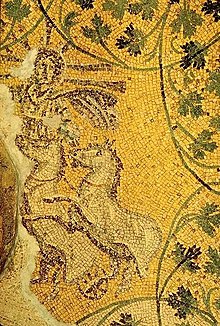| Revision as of 23:27, 1 March 2015 editCydebot (talk | contribs)6,812,251 editsm Robot - Speedily moving category Roman Mosaic to Category:Roman mosaics per CFDS.← Previous edit | Revision as of 18:57, 5 July 2015 edit undoIronMaidenRocks (talk | contribs)Extended confirmed users3,138 editsmNo edit summaryNext edit → | ||
| Line 1: | Line 1: | ||
| {{coord|41|54|8|N|12|27|12|E|display=title}} | {{coord|41|54|8|N|12|27|12|E|display=title}} | ||
| ] | ] | ||
| The popularly-named '''"Tomb of the Julii"''' (Mausoleum "M") survives in the ] beneath ]. The serendipitous discovery near the ] has a vaulted ceiling bearing a ] depicting ] (Roman ]) with an aureole riding in his chariot, within a framing of rinceaux of vine leaves, which are not given their usual pagan ] reading in this context but are related to the True Vine imagery of ] 15.1. The mosaic is dated to the late 3rd century to early 4th century. Other mosaics in this tomb depicting Jonah and the whale, the good shepherd carrying a lamb (the '']'' motif), and fishermen have encouraged its interpretation as a Christian tomb. | The popularly-named '''"Tomb of the Julii"''' (Mausoleum "M") survives in the ] beneath ]. The serendipitous discovery near the ] has a vaulted ceiling bearing a ] depicting ] (Roman ]) with an ] riding in his chariot, within a framing of rinceaux of vine leaves, which are not given their usual pagan ] reading in this context but are related to the True Vine imagery of ] 15.1. The mosaic is dated to the late 3rd century to early 4th century. Other mosaics in this tomb depicting Jonah and the whale, the good shepherd carrying a lamb (the '']'' motif), and fishermen have encouraged its interpretation as a Christian tomb. | ||
| ==See also== | ==See also== | ||
Revision as of 18:57, 5 July 2015
41°54′8″N 12°27′12″E / 41.90222°N 12.45333°E / 41.90222; 12.45333

The popularly-named "Tomb of the Julii" (Mausoleum "M") survives in the Vatican Necropolis beneath St. Peter's Basilica. The serendipitous discovery near the crypt has a vaulted ceiling bearing a mosaic depicting Helios (Roman Sol Invictus) with an aureole riding in his chariot, within a framing of rinceaux of vine leaves, which are not given their usual pagan Dionysiac reading in this context but are related to the True Vine imagery of Gospel of John 15.1. The mosaic is dated to the late 3rd century to early 4th century. Other mosaics in this tomb depicting Jonah and the whale, the good shepherd carrying a lamb (the kriophoros motif), and fishermen have encouraged its interpretation as a Christian tomb.
See also
References
- Beckwith, John 1979. Early Christian and Byzantine Art (Yale University Press): 19
- Perler, Othmar 1953, Die Mosaiken der Juliergruft im Vatikan (Universitätsverlag): 34-36
Further reading
- Weitzmann, Kurt, ed., Age of spirituality: late antique and early Christian art, third to seventh century, no. 467, 1979, Metropolitan Museum of Art, New York, ISBN 9780870991790
This Vatican City–related article is a stub. You can help Misplaced Pages by expanding it. |
This decorative art–related article is a stub. You can help Misplaced Pages by expanding it. |
This Catholic Church–related article is a stub. You can help Misplaced Pages by expanding it. |